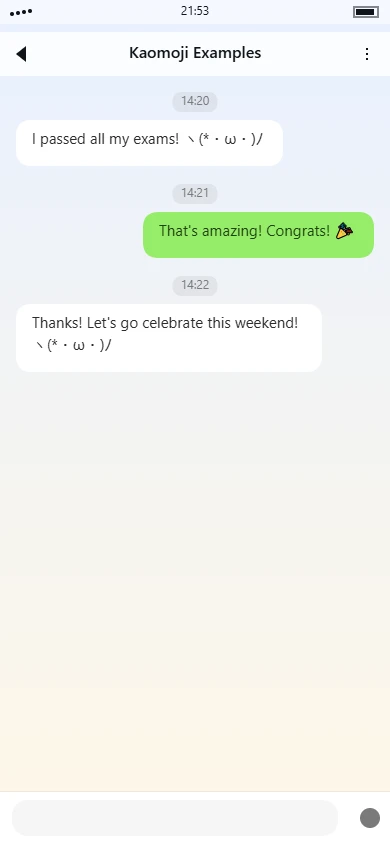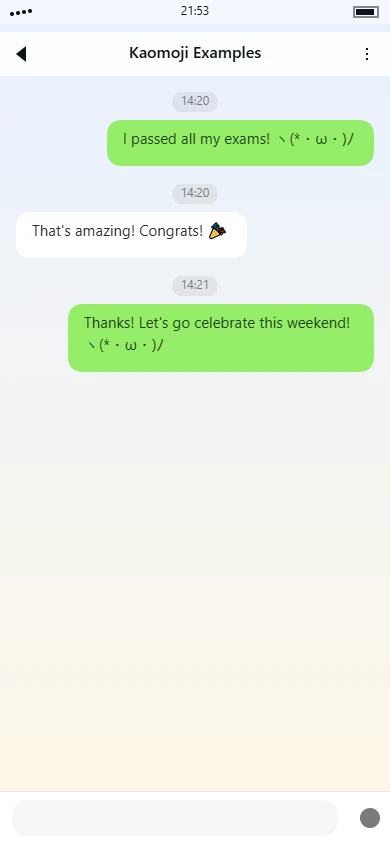(„• ᴗ •„) kaomoji meaning | usage tips

Overview
The kaomoji („• ᴗ •„) presents a distinctive facial expression that combines elements of cuteness with a subtle pleading quality. Its visual structure is built around a central smiling mouth flanked by two eye elements, all enclosed within curved parentheses that suggest a soft facial outline. The arrangement creates a balanced, symmetrical appearance that draws attention to the central expression while maintaining a cohesive overall form.
Symbol Breakdown
-
Curved parentheses ( ): These symbols frame the face, creating a rounded contour that suggests softness and approachability. The parentheses are not perfectly round but have a gentle curvature that contributes to the overall organic feel.
-
Lowered quotation marks („): The use of lowered quotation marks as eyes is notable - they appear slightly below the typical eye position, creating a downward gaze effect that contributes to the pleading expression.
-
Middle dots (•): Positioned immediately after the quotation marks, these dots serve as pupils or highlights in the eyes, adding focus and definition to the gaze direction.
-
Small capital letter (ᴗ): This character forms the mouth element, with its upward curve representing a subtle smile. The small capital form gives it a compact, rounded appearance that fits well within the facial structure.
Emotion & Aesthetic Analysis
The emotional tone of this kaomoji leans toward gentle appeal rather than overt excitement. The downward positioning of the eye elements combined with the modest upward curve of the mouth creates a mixed expression - not quite sad, but carrying a sense of hopeful request. This differs from more exuberant smiling kaomoji that use wider grins or upward-facing eyes.
In terms of aesthetic style, the kaomoji employs a balanced approach to character selection. The mixture of punctuation marks, middle dots, and specialized typographic characters creates visual interest without becoming overly complex. The spacing between elements is consistent, allowing each component to remain distinct while contributing to the unified facial expression. The overall effect is somewhat reminiscent of a character making a polite request or showing hopeful anticipation.
When compared to similar kaomoji, this version stands out for its specific combination of lowered eyes with a gentle smile. Other kaomoji might use similar elements but arranged differently - for instance, eyes positioned higher for a more cheerful expression or a wider mouth for greater enthusiasm. The particular arrangement here suggests a nuanced emotional state that falls between happiness and supplication, making it suitable for situations where one wants to express hopeful asking without appearing desperate or overly emotional.
Tag categories
Use tags to quickly understand this kaomoji.
Object tags
Click tags to explore related kaomoji.
Usage guide
Usage Guide for („• ᴗ •„)
The kaomoji („• ᴗ •„) is a charming and versatile emoticon that conveys a range of positive emotions with a distinctly cute and slightly shy aesthetic. Characterized by its rounded cheeks („) and a small, happy mouth (ᴗ) nestled between dot eyes (• •), this expression radiates warmth, contentment, and gentle playfulness. It's particularly effective in digital communication where text alone might feel too stark, serving as a softener for messages and helping to establish a friendly, approachable tone. You'll commonly see it used among friends in casual chats, in social media comments to show appreciation, or in gaming communities to express lighthearted satisfaction. Its overall vibe is one of wholesome happiness, making it unsuitable for serious or formal contexts but perfect for building rapport in informal settings.
Common Use Cases
- Reacting to a friend sharing good news about their personal life
- Responding to a cute pet picture or video in a group chat
- Expressing quiet satisfaction after solving a difficult puzzle in a game
- Commenting on a comforting meal photo on social media
- Acknowledging a thoughtful gesture from a coworker in a casual work chat
- Showing gentle amusement at a clever but harmless joke
- Reacting to someone's creative project that you find endearing
- Expressing cozy contentment while describing a relaxing weekend plan
- Responding to a friend's nostalgic memory that brings a smile to your face
- Showing appreciation for a small act of kindness in an online community
- Accompanying a message about looking forward to a simple pleasure
- Expressing mild, happy surprise at an unexpected but pleasant outcome
Example Conversations
-
Friend Chat
Person A: "Just finished baking cookies, and they actually turned out perfect!" Person B: "That's amazing! Save some for me („• ᴗ •„)"
-
Social Media Comment
Post: "Spent the afternoon reading in the park with my dog" Comment: "This looks like the perfect day („• ᴗ •„) so peaceful!"
-
Gaming Community
Player A: "Finally beat that boss after 10 tries!" Player B: "Nice! That feeling of accomplishment („• ᴗ •„)"
-
Casual Work Message
Colleague: "I brought extra coffee if anyone wants some" You: "You're a lifesaver („• ᴗ •„) thank you!"
-
Family Group Chat
Sibling: "Remember that ice cream place we used to go to as kids?" You: "Yes! Those summer days were the best („• ᴗ •„)"
-
Online Community
User: "Here's a drawing I made of my cat sleeping" Response: "This is absolutely precious („• ᴗ •„) you captured the coziness perfectly!"
Important Notes
- Avoid using this kaomoji in formal professional emails, serious business discussions, or when addressing sensitive topics where its cute tone might seem inappropriate or dismissive
- The expression carries a distinctly gentle, non-confrontational energy that works best in positive or neutral contexts rather than during debates or disagreements
- While universally recognizable as positive, its specific "shy cute" aesthetic may be interpreted slightly differently across cultures - in some contexts it might read as more childish or feminine
This kaomoji works particularly well on platforms like Discord, Twitter, and casual messaging apps where cute aesthetics are widely appreciated. Its rounded, soft appearance makes it especially effective when you want to convey happiness without appearing overly excited or intense.
Usage examples
Real conversation samples that feature this kaomoji.

Example 1

Example 2
Related kaomoji
You might also enjoy these kaomoji.